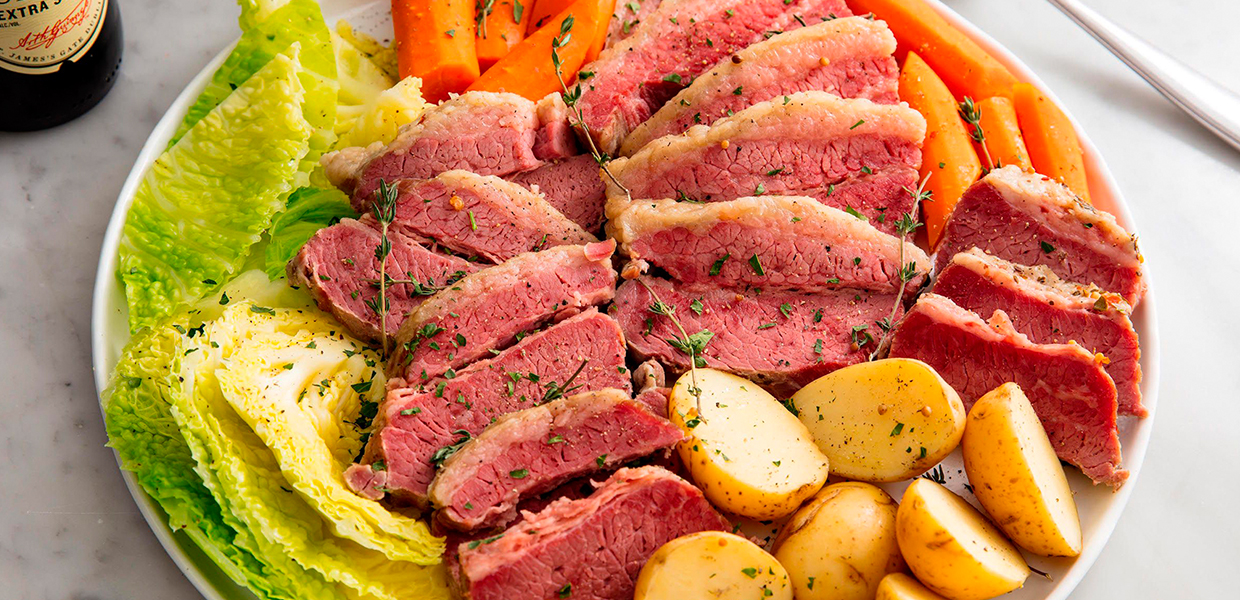BRINE IT!
By Chef K. Marie Paulk
In general, to me, boiled meat does not conjure up images of delightful meals; however, come March 17th, all of that changes. That’s the unique day when we all roll out our green and claim a bit of Irish in our ancestry. Not many simpler or tastier tasks exist than boiling a corned beef for 4 to 6 hours and then making a meal of it with boiled potatoes and vegetables with a cold beer.
How did Corned Beef Brisket — which is cured in pickling brine containing salt, pepper, spices and potassium nitrate (AKA “saltpeter” that preserves the meat’s red color) — come to be the meal of choice every March 17th? To start, the term “corned” comes from the size of the salt grain used — approximately the size of a corn kernel. While the precise origins of corned beef have been lost in the pages of history, significant commercial production began with British industrialization and expansion in the 17th century, with much of it taking place in Ireland for cheaper labor. The Irish ironically did not consume corned beef much, as it was too expensive for them and considered a luxury item at the time.
Corned beef played a significant role in the potato famine of the mid-19th century, in turn creating the Irish migration to America. Because the Irish valued corned beef as an important export, they dedicated much of their agricultural land to cows, rendering the native Irish to do much of their farming for their food on lower-quality land (where the potato seemed to thrive). That famine, in addition to pushing many Irish to these shores, also pushed corned beef production to South America, as the need for cheap labor remained. In about 1873 in Uruguay, at the river port of Fray Bentos, corned beef began production under the label of Fray Bentos. Millions of pounds exported from then through WWII––and even today, as much as 80% of the world’s corned beef originates in South America, though not in Uruguay, but now from Brazil. Ironically today, Fray Bentos produces very little corned beef, and they have moved their production to Scotland.
In a twist of fate, after waves of Irish immigrants came to America, the once luxury product of corned beef from their homeland was much more affordable here due to its production in South America––which caused Irish-Americans to become big consumers of the product! As such, that is the root of how corned beef became the traditional dish for St. Patrick’s Day. Who knew that the quest for cheap labor and famine would significantly influence our meal planning every March 17th?
History aside, I know that many of us are trying to eat “cleaner,” so I would ask the question: “How about making homemade corned beef?” Those cryovac packages of beef, to me, seemed a bit foreboding. Yes, cryovac secures all the juices and moisture inside the package and will preserve the meat for relatively long periods, yet it does not enhance the flavor one bit. Are you up for the challenge of brining your own brisket? If you can plan about 4 or 5 days out and have space in your refrigerator, it may be worth your while.
Start with a 7 lb. boneless brisket (preferably), but you can substitute a top or bottom round with all the fat trimmed. NOTE: boneless is essential because the bone will rot and not pickle.
Then gather your spices:
24 juniper berries
12 black peppercorns
12 all spice berries
4 whole cloves
2 cardamom pods
Toast those in a frying pan by getting it hot (with NO oil), almost smoking, then add all the spices, and immediately remove from the heat and let the spices toast for approximately 5 minutes or until the pan is fully cool, shaking the pan a few times so they toast evenly. Once cooled, place the spices into a piece of cheesecloth and tie securely.
Bring 4 ½ quarts of water to a boil, adding:
Your cheesecloth bag of spices
2 ½ lbs. sea salt
3 cups of packed dark brown sugar
Optional: If you want your meat to have the traditional corned beef pink color, you need to add 5 teaspoons of pink pickling salt (NOTE: This is NOT Himalayan Pink Salt and it CAN be toxic if ingested directly).
Let the water boil for 15 minutes to dissolve the salt and sugar to make the liquid very salty. Remove from heat, add 6 cups of ice-cold water and let cool.
Then add the brisket and 6 bay leaves to the brine. NOTE: The meat has to be completely covered in the brine, so, add a plate or a weight to ensure that it stays fully submerged. Then refrigerate for 4 or 5 days, turning the meat daily.
When you’re ready to cook, remove the brisket from the brine and rinse (the brine can be discarded). Then slow cook as you would a traditional corned beef. I recommend adding a beer to your stock, which adds a malty flavor. I typically use a stout, like Guinness, but I have heard that a porter will add a hint of sweetness. Also, remember to not throw out the stock — save it for your cabbage, potatoes, and vegetable.
Enjoy the day and the meal. I know I’m looking forward to it. Don’t forget the soda bread!















































